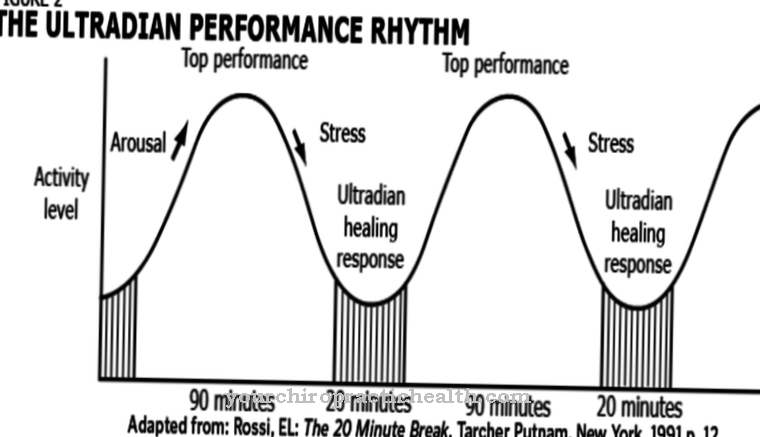Oxidations are chemical reactions with the consumption of oxygen. In the body, they are particularly important in connection with the generation of energy during glycolysis. The body's own oxidations produce oxidative waste, which is associated with aging processes and various diseases.
What is the Oxidation?

The chemist Antoine Laurent de Lavoisier coined the term oxidation. He used the name to describe the union of elements or chemical compounds with oxygen. The term was later expanded to include dehydrogenation reactions in which a hydrogen atom is removed from compounds. Dehydration is an important process in biochemistry.
In biochemical processes, for example, hydrogen atoms are often removed from organic compounds by coenzymes such as NAD, NADP or FAD. In biochemistry, an electron transfer reaction is ultimately known as oxidation, in which a reducing agent gives off electrons to an oxidizing agent. The reducing agent is "oxidized" in this way.
Oxidations in the human body are generally associated with reduction reactions. This principle is described in the context of the redox reaction. Reductions and oxidations are therefore always only to be understood as partial reactions of the common redox reaction. The redox reaction thus corresponds to a combination of oxidation and reduction, which transfers electrons from the reducing agent to the oxidizing agent.
In the narrower sense, every chemical reaction that consumes oxygen is considered a biochemical oxidation. In a broader sense, oxidation is any biochemical reaction with electron transfer.
Function & task
Oxidation corresponds to the release of electrons. Reduction is the uptake of the given electrons. Together, these processes are known as the redox reaction and form the basis of any type of energy generation. The oxidation releases the energy that is absorbed during the reduction.
Glucose is an easily storable energy supplier and at the same time an important building block for cells. Glucose molecules make up amino acids and other vital compounds. In biochemistry, the term glycolysis describes the oxidation of carbohydrates. Carbohydrates are broken down into their individual components in the body, i.e. into glucose and fructose molecules.
Within cells, fructose is converted to glucose relatively quickly. In the cells, glucose with the molecular formula C6H12O6 is used to generate energy by consuming oxygen with the molecular formula O2, whereby carbon dioxide with the molecular formula CO2 and water with the formula H2O are created. This oxidation of the glucose molecule thus supplies oxygen and breaks down hydrogen.
The goal of every oxidation of this kind is to obtain the energy supplier ATP. For this purpose, the described oxidation takes place in the cytoplasm, in the mitochondrial plasma and in the mitochondrial membrane.
In many contexts, oxidation is referred to as the basis for life, as it guarantees the production of the body's own energy. A so-called oxidation chain takes place within the mitochondria, which is crucial for human metabolism, because all life is energy. Living beings use their metabolism to generate energy and thus to ensure survival.
In the case of oxidations within the mitochondria, in addition to the reaction product energy, there is also oxidation waste. This garbage corresponds to chemically active compounds that are considered free radicals and are kept in check by the body by enzymes.
Illnesses & ailments
Oxidation in the sense of a breakdown of high-energy to low-energy compounds occurs continuously in the human body while generating energy. In this context, oxidation is used to generate energy and takes place in the mitochondria, which are also referred to as the cells' small power plants. The body's own high-energy compounds are stored in the body as ATP after this type of oxidation.
The energy source for oxidation is food, for whose conversion oxygen is required. This type of oxidation produces aggressive radicals. The body normally intercepts these radicals using protective mechanisms and neutralizes them. One of the most important protective mechanisms in this context is the activity of non-enzymatic antioxidants. Without these substances, radicals would attack human tissue and, above all, cause permanent damage to the mitochondria.
High physical and mental stress increases metabolism and oxygen consumption, which leads to increased radical formation. The same applies to inflammation in the body or exposure to external factors such as UV radiation, radioactive rays and cosmic rays or environmental toxins and cigarette smoke.
Protective antioxidants such as vitamin A, vitamin C, vitamin E and carotenoids or selenium are no longer able to absorb the harmful effects of radical oxidation when exposed to increased exposure to radicals. This scenario is associated with both natural aging and pathological processes such as the development of cancer.
Malnutrition, poison consumption, radiation exposure, extensive sport, mental stress and acute and chronic illnesses create more free radicals than the body can handle. Free radicals either have one electron too many or too little. To compensate, they try to take electrons from other molecules, which can lead to the oxidation of the body's own components such as lipids within the membrane.
Free radicals can cause mutations in nucleus DNA and mitochondrial DNA. In addition to cancer and the aging process, they are associated with arteriosclerosis, diabetes, rheumatism, MS, Parkinson's, Alzheimer's and immunodeficiency or cataracts and high blood pressure.
Free radicals link [protein]] s, sugar-proteins and other basic substance components with each other and thus make it more difficult to remove acidic metabolic waste. The environment is becoming more and more favorable for pathogens, as the connective tissue in particular "acidifies".








.jpg)



















